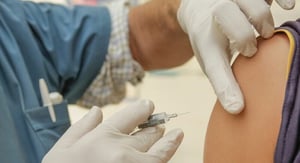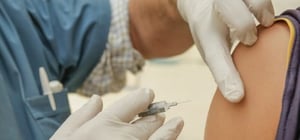Shire plc (LON: SHP, NASDAQ: SHPG), the leading global biotechnology company focused on rare diseases, today announced that the European Medicines Agency’s (EMA) Committee for Medicinal Products for Human Use (CHMP) adopted a positive opinion recommending the granting of marketing authorisation of lanadelumab injection for routine prevention of recurrent attacks of hereditary angioedema (HAE) in patients aged 12 years and older. If approved, lanadelumab will be a first-of-its-kind, fully human monoclonal antibody (mAb) available in the EU that inhibits the activity of plasma kallikrein, an enzyme which is uncontrolled in people with HAE, to help prevent attacks.1
HAE is a rare, genetic disorder estimated to affect about 1 in 10,000 to 1 in 50,000 people worldwide.2,3 The condition results in recurring attacks of oedema (swelling) in various parts of the body, including the abdomen, face, feet, genitals, hands and throat, that can be debilitating and painful. Laryngeal attacks that obstruct the airways are potentially life-threatening due to the risk of asphyxiation.2,4,5
“This positive opinion marks an important step towards providing adults and adolescents living with HAE in Europe a first-of-its-kind monoclonal antibody treatment option to help prevent attacks,” said Andreas Busch, Ph.D., Executive Vice President, Head of Research and Development at Shire. “We are excited about the future potential of lanadelumab in helping to address the needs of those living with this chronic and unpredictable disease.”
The positive opinion is supported by data from the Phase III HELP (Hereditary Angioedema Long-term Prophylaxis) Study™, the largest randomised controlled prevention study conducted to date in HAE, which evaluated the efficacy and safety of subcutaneously administered lanadelumab versus placebo over 26 weeks in 125 patients 12 years of age or older with HAE.6
Lanadelumab was previously granted accelerated assessment by the EMA, reducing the number of evaluation days required from 210 to 150. The CHMP’s positive opinion will be reviewed by the European Commission, which has the authority to grant marketing authorisation in the EU.
Lanadelumab received approval for the prevention of HAE attacks in patient 12 years and older in the U.S. on 23 August 2018 and Canada on 19 September 2018, under the brand name TAKHZYRO™.1,7
Supportive Data
The CHMP submission was based on outcomes of the HELP Study™, a multicentre, randomised, double-blind, placebo-controlled parallel group trial that evaluated the efficacy and safety of subcutaneously administered lanadelumab versus placebo over 26 weeks in 125 patients 12 years of age or older with HAE.6
The primary endpoint of the HELP Study™ was the number of investigator-confirmed HAE attacks over the entire 26-week study duration. Lanadelumab demonstrated that subcutaneous injections every two or four weeks reduced the mean monthly number of attacks across all three lanadelumab treatment arms studied: 300 mg every two weeks, 300 mg every four weeks, and 150 mg of lanadelumab every four weeks. At 300 mg every two weeks, lanadelumab reduced the number of mean monthly HAE attacks by 87% vs. placebo (adjusted P<0.001).6
Overall, each lanadelumab treatment arm demonstrated statistically significant attack rate reductions compared with placebo for all secondary efficacy endpoints (adjusted P<0.001 for all comparisons). Patients taking lanadelumab 300 mg every 2 weeks had 83% fewer moderate or severe attacks and 87% fewer attacks that needed on-demand treatment. A pre-specified, exploratory analysis showed that 44% of patients (n=27) receiving lanadelumab 300 mg every two weeks had zero attacks compared to placebo (2%, n=41) for the 26-week treatment period.1 Additionally, in a post hoc sensitivity analysis of the steady state period from Day 70 to Day 182, 77% of patients (n=26) treated with lanadelumab in the same dosage arm of the trial were attack-free compared to placebo (3%, n=37).8
Relevant Safety Information from the HELP Study™
No serious Treatment Emerging Adverse Events (TEAEs) or deaths were reported.
The most common TEAE was HAE attack. The most commonly reported adverse events, excluding events related to HAE attacks, were injection site pain (42.9%), followed by upper respiratory infection (23.8%), headache (20.2%) and injection site erythema (9.5%). The majority of TEAEs were mild to moderate in severity. TEAEs resulted in discontinuation for 1 patient from the 300 mg every four weeks lanadelumab arm (ALT/AST elevation) and 2 from the placebo arm (tension headache, HAE attack).
About lanadelumab
Lanadelumab, a fully human monoclonal antibody that specifically binds and decreases plasma kallikrein activity, is currently being evaluated by the EMA for routine prevention of recurrent attacks of hereditary angioedema (HAE) in patients aged 12 years and older. Lanadelumab is formulated for subcutaneous administration and has a half-life of approximately two weeks in patients with HAE.6 Lanadelumab is intended for self-administration or administration by a caregiver, only after training by a healthcare professional.
For full U.S. and Canada Prescribing Information, including the approved indications and important safety information, please visit US Prescribing Information and the Canadian Product Monograph.
Shire’s Commitment to Hereditary Angioedema
Shire is a dedicated, long-term partner to the HAE community with a decade of experience supporting patients. We are committed to serial innovation in HAE and our portfolio of products includes a number of therapy options to help meet the individual needs of those living with the disease. Beyond our focus on developing novel treatments, we provide specialised services and support offerings tailored to the HAE community.





































